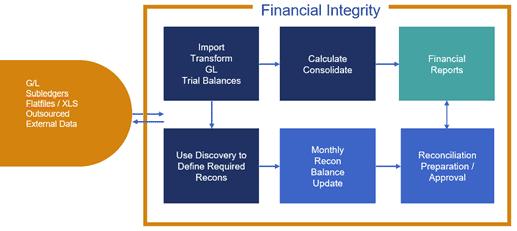Automation is a well-used word – perhaps even overused. Why? Well, automation is pretty much being mentioned in almost every area of life right now. Digitalisation and changes in technology are bringing ever-increasing opportunities to both reduce time spent and eliminate errors.
Anything repetitive and time-consuming is a clear candidate for automation. Account reconciliations surely fall into both categories! The process is essentially the same every time, and many accounts reconcile the first time without the need to explore any detail. Really? Yep, in fact, according to EY’s 2020 CFO survey, 95% of Finance teams’ efforts are wasted on transactions that already match, rather than spending that time on problem entries that actually require attention.
Automation becomes even more important considering that, according to a 2022 Ventana Research Finance Benchmark survey, still 43% of organisations take longer than 6 days to close the books. Astonishingly, according to Accounting Web in 2021, 30% of survey respondents reported taking 16-19 working days to close the books. The pressure is clearly mounting to reduce close times, get results out to stakeholders faster and make more effective decisions about future direction. Accelerating account reconciliations can really make a huge difference and make it easier to do all of that and more.
In this blog, we examine why a fully integrated account reconciliations capability, along with the ability to load and match transactions, is critical to ensuring a timely financial close.
The Challenge
For many organisations, the account reconciliations process not only involves manual, time-consuming work but also causes significant delays in the financial close process. Why? Well, most medium- to large-sized global companies must reconcile hundreds to thousands of accounts during the quarter-end or month-end close across the parent company and various subsidiaries. Also related to this process is the need to reconcile data between multiple software applications used to run the business. The more systems, the more reconciliations required.
Leading Finance departments are attempting to eliminate the risks of manual processes — missing or lost reconciliations, unreconciled accounts, improper use of roll-forwards, and insufficient justification or documentation — to protect their organisations against costly mistakes. Many have adopted standalone account reconciliations software applications to deal with these issues.
However, that solution is not always the right answer. Why? Well, with standalone account reconciliations applications, a “data integrity gap” (see Figure 1) exists between the account reconciliations and the financial statements. When accounts are reconciled in a system separate from the financial reporting process, out-of-sync data easily occurs, causing delays in the close process and issues with data integrity.
The Solution
The key to more effective account reconciliations is to not only automate the process but also fully unify it with the financial close. If GL trial balances are loaded into a single system for financial consolidation, reporting, and account reconciliations, then the data will always be synchronised, and the close process will be faster and more efficient. Importantly, one single trial balance load can, in parallel, feed all reporting processes, including account reconciliations, from the same source. That ability reduces the risk of differences and speeds the close.
An integrated unified system should include an automated transaction matching capability to help resolve differences and accelerate the account reconciliation process by providing the ability to quickly match transactional data from multiple sources.
Here are several reasons automation is key to such functionality:
- Reduces manual steps
- Avoids error-prone reconciliations in spreadsheets
- Allows matching to use a rule-based approach so that users can focus on the exceptions and drive process efficiencies
If the process is fully automated and unified, then the benefits of leveraging the same trial balances across the close and compliance processes become very clear. How? Well, data often changes constantly in the close process. Such updates, in an automated system, continue to get reflected across processes without having to physically move data between separate connected Finance solutions. And that eliminates the data integrity gap (see Figure 2).

Figure 2 – The Unified Approach – Eliminates the Data Integrity Gap
Why OneStream?
OneStream’s single unified platform approach and financial data quality management capabilities are unique in the market. The Account Reconciliations and Transaction Matching solutions are both available to all customers as free downloads from the OneStream Marketplace, part of the OneStream Solution Exchange which makes available more than 75 other business process solutions. Using these solutions, organisations can then incorporate account reconciliations and transaction-level matching directly into daily, weekly, or monthly tasks and workflows, which are also managed in OneStream.
Delivering 100% Customer Success
It’s this capability to unify financial close processes in parallel and without the complexity that gives OneStream the ability to replace multiple legacies or connected Finance applications and spreadsheets. And it’s a big opportunity for organisations to drive total-cost-of-ownership savings and generate returns from their OneStream investment. Here are a few examples of customers we have worked with and the benefits they have achieved:

The Carlyle Group was looking to simplify its CPM landscape by combining three disparate tools into a single platform. Additionally, they were seeking a modern, extensible platform that was scalable to meet current and future business needs – and one which would provide their business areas with more control of reconciliations.
After implementing OneStream for financial close, consolidation, reporting, budgeting, and people planning, the group successfully adopted OneStream Account Reconciliations, and all areas of the organisation can now reconcile within a single tool, eliminating all offline reconciliations. The group can also now enforce accounting policies, such as thresholds, frequency, and other requirements. Plus, they’ve increased the level of auditability and traceability by having one single source of data for financial reporting and reconciliations.

After implementing OneStream for financial close, consolidation, reporting, and budgeting, AFL replaced Blackline with OneStream’s Account Reconciliations solution. As a result, AFL says OneStream’s approach has sped up their account reconciliations process by 75% and saved them about $100K per year in software licenses.
The dream of ‘one version of the truth is entirely possible with OneStream.
Learn More
To learn more about how you can accelerate the financial close with the unrivalled power of OneStream’s Unified Platform, download our whitepaper. Need help accelerating the financial close and eliminating the integrity gap? Contact OneStream today!
Download the White PaperGet Started With a Personal Demo



